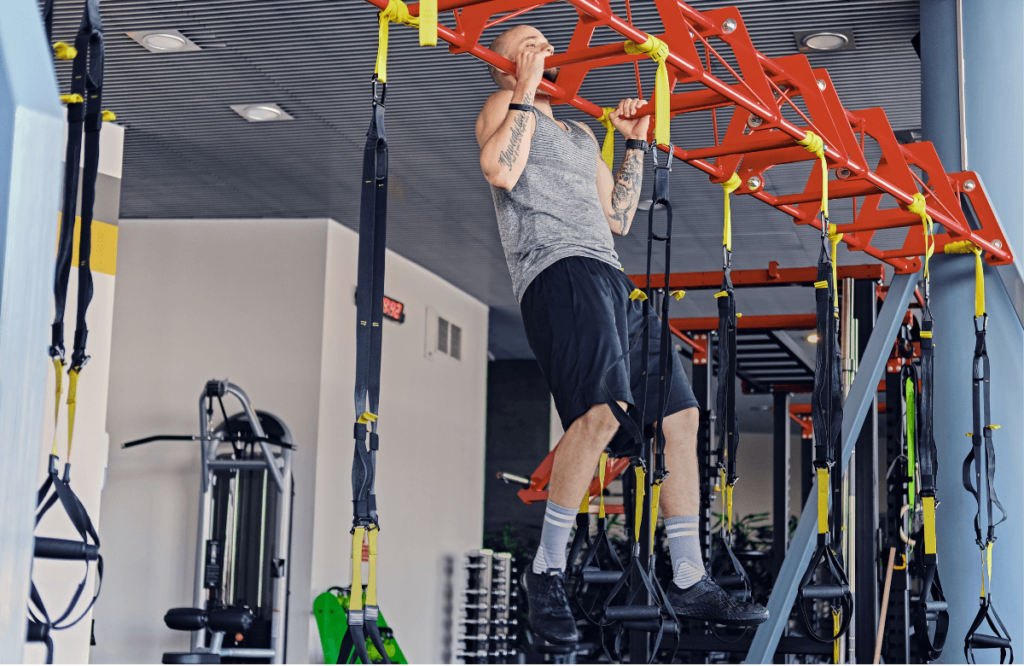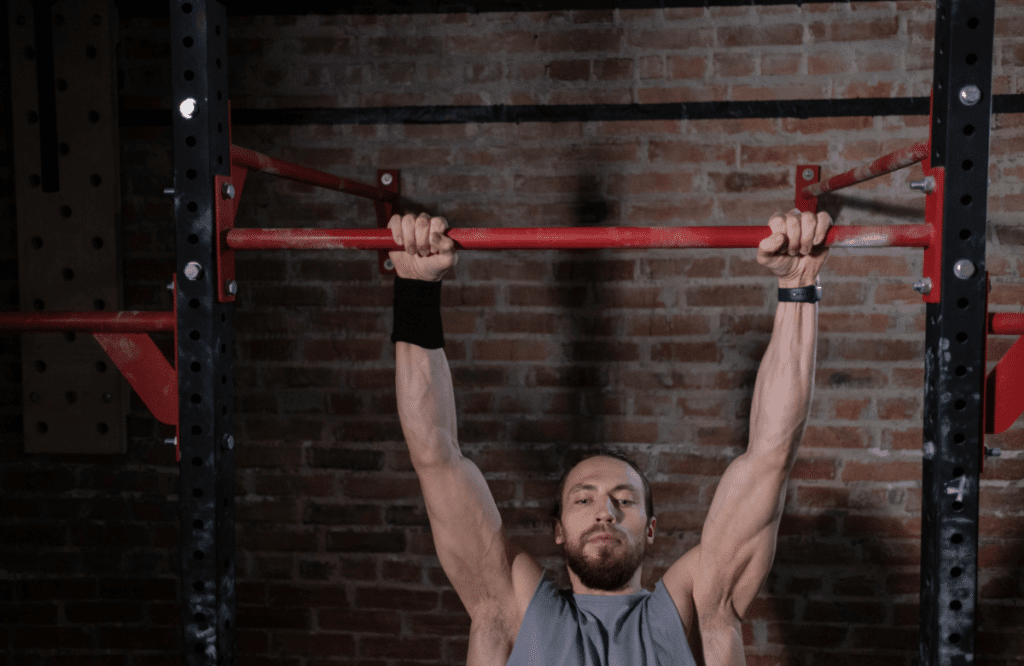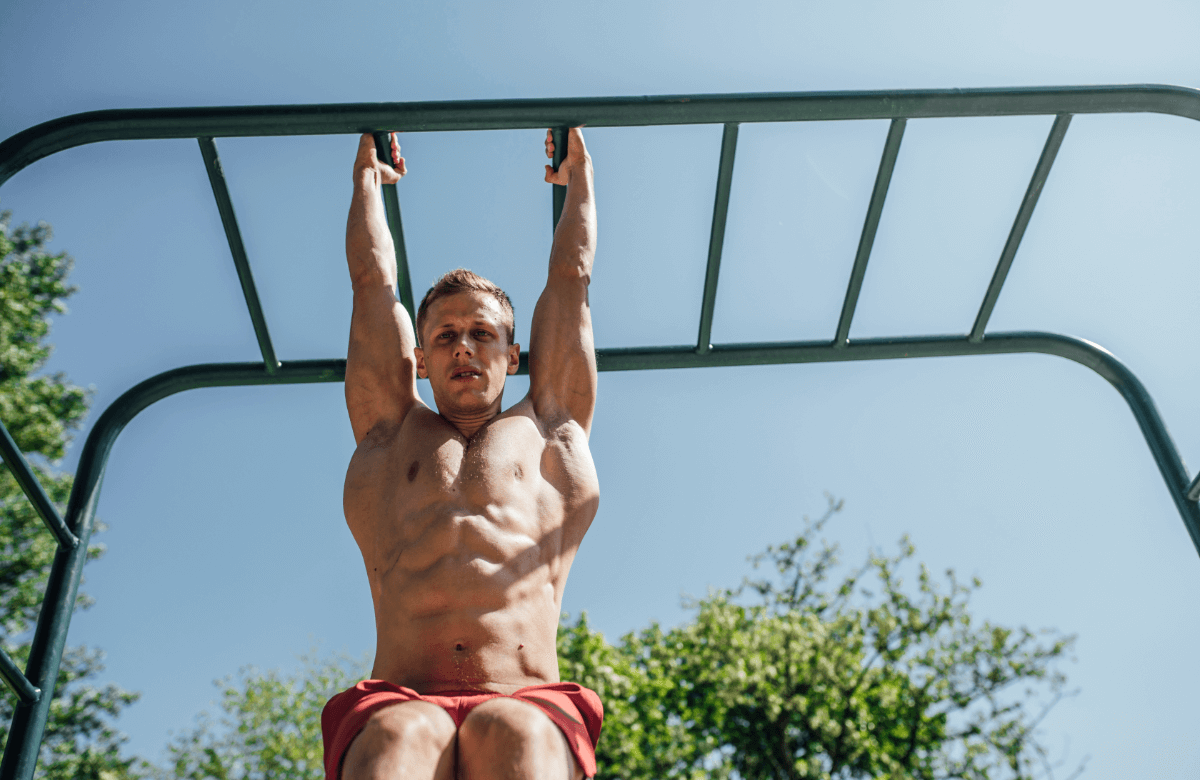The not-so-humble pull-up is a challenging exercise for novice and veteran lifters alike. It’s a cornerstone of strength, requiring control and endurance. But did you know your hand position can alter the difficulty and muscle engagement?
So, what about the Neutral Grip Pull-Up ? Is this option right for you?
This article covers everything you need to know to master the Neutral Grip Pull-Up, including technique, benefits, common mistakes, and more. Read on for more information.
Jump to:
What Is the Neutral Grip Pull-Up?
A Neutral Grip Pull-Up, or Hammer Grip, is a variation of the traditional pull-up exercise, commonly used to strengthen the upper body’s muscles, especially the back, shoulders, and arms.
In a neutral grip pull-up, you use a specific starting position where the palms face one another, which is different from the traditional pronated grip.
- It can provide more wrist and shoulder comfort.
- Emphasizes different muscle groups.
- Provides more training variation.
This exercise variation does require a parallel pull-up bar, which is available at most commercial gyms or home equipment set-ups. Hammer grip pull-ups can be a helpful exercise variation in any upper body program to engage the upper body muscles and develop grip strength.
What Muscles Does the Neutral Grip Pull-Up Work?
As a compound exercise, the neutral grip pull-up targets several major muscle groups in the upper body. The muscles worked during this pull-up variation include the following:
Latissimus Dorsi (Lats)
The Latissimus Dorsi muscles are the large muscles of the back and are the primary muscles responsible for the pulling motion in a pull-up. They are heavily engaged in both the concentric (lifting) and eccentric (lowering) phases of the exercise.
Muscles in the Upper Back
Neutral pull-ups also engage multiple muscle groups in the upper back, namely the rhomboids and traps.
The Rhomboid muscles, located between the shoulder blades, are engaged as they help retract the shoulder blades and stabilize the upper back during the movement.
The Trapezius muscles, especially the upper and middle fibers, are used to stabilize the shoulders and control the movement of the scapula (shoulder blades).
Biceps Brachii
The Biceps muscles are on the front of the upper arm and are heavily engaged during neutral grip pullups, especially during the concentric phase when you pull your body upward.
Neutral pull-ups engage the biceps similarly to the underhand grip variation, making it a great exercise selection for developing arm strength. Bicep strength is used in countless daily activities, from lifting heavy objects, raising a fork, or opening doors.
Teres Major
The Teres Major is in the upper back, near the shoulder blade, is involved in shoulder extension and adduction, and is activated during the pull-up.
Arm Muscles
The arms are used extensively during the neutral grip pull-up, including the brachialis, brachioradialis, and the forearms.
This Brachialis muscle, located underneath the biceps, is also activated during a neutral grip pull-up, contributing to elbow flexion.
The brachioradialis, a muscle on the forearm, is engaged as it helps stabilize the wrists and assists in elbow flexion during the exercise.
Lastly, the forearm helps you maintain your grip on the bar’s parallel handles during the neutral grip variation.

How to Perform the Neutral Grip Pull-Up
Proper form is a must for any upper body exercise, but especially for neutral grip pullups. The pull-up movement requires control and stability to achieve the most muscle growth. Here’s how:
Step 1: Set Up at the Pull-Up Bar
Find a pull-up bar with parallel handles or attachments that allow you to grip the bar with your palms facing each other (thumbs pointing toward each other). These handles are often referred to as “neutral grip handles” or “parallel grips.”
Stand or jump up to grip the handles while hanging from the bar.
Your hands should be facing one another, roughly shoulder distance apart or a bit wider, depending on your comfort or preference.
Step 2: Start From a Dead Hang
Hang from the bar with your arms fully extended and your body in a straight line. Take a deep breath and brace your core.
Step 3: Pull Your Body Up
Begin the pull-up by retracting your shoulder blades and engaging your back and arm muscles. Pull your body upward until your chin clears the bar.
Slowly lower your body back down to the starting stance with control, fully extending your arms. Repeat the movement for your desired rep range.
Common Mistakes to Avoid
Whether you’re using a neutral, underhand, or pronated grip, the pull-up movement can be challenging. Bad form can lead to less muscle activation or, in some cases, shoulder injury.
Here are a few common form mistakes to watch out for when neutral pull-ups:
Incomplete Range of Motion
The United States Marine Corps doesn’t require recruits to get their chin over the bar just for fun—this is the full range of motion and correct form for pull-ups.
Ensure you start with your arms fully extended and pull yourself up until your chin clears the bar. Lower yourself back down with control until your arms are fully extended again. Doing so ensures peak muscle activation.
Using Momentum
Depending on your strength level, you might start to kick or swing your body to complete the last few pull-up reps. This is typically called “kipping” and can reduce the effectiveness of the pull-up movement.
Instead, focus on controlled and deliberate movements to use your upper body strength to the fullest. This will engage the correct muscles thoroughly, helping you develop more muscle mass.
Not Engaging the Core
Although they’re commonly part of upper body strength training routines, neutral grip pull-ups work the various stabilizer muscles throughout the core and the lower body.
Neglecting to engage your abdominal muscles might lead to incorrect form, instability, and poor muscle recruitment. Instead, maintain a tight core throughout the movement to maintain proper alignment and stability.
Not Controlling the Descent
Lowering your body weight too quickly or without control can put unnecessary stress on your joints and shoulder muscles. This can lead to repetitive strain injuries, rotator cuff pain, or other negative symptoms.
Instead, lower your body with control to work both the concentric and eccentric phases of the exercise.
Use the Correct Form
Simple form mistakes can make a significant difference in the effectiveness of neutral grip pull-ups.
Remember, proper shoulder blade retraction is crucial for engaging the back muscles effectively. Ensure you retract your shoulder blades (squeeze them together) as you initiate the pull.
Avoid rounding your upper back or excessively arching your lower back as well. Maintaining a neutral spine position will protect your back and maximize muscle engagement.

What Are the Benefits of Neutral Grip Pull-Ups?
Neutral grip pull-ups offer several benefits for individuals looking to strengthen their upper body and improve their overall fitness. Here are some of the key benefits of incorporating this pull-up variation into your workout routine:
Target Multiple Muscle Groups
The type of grip you use will determine the difficulty and muscle recruitment. Compared to the pronated grip pull-up, the neutral hand position engages the biceps and forearms more, making it a great arm exercise.
It also targets the same primary muscles of traditional overhand grip variation, including the lats, rhomboids, and trapezius. This exercise provides a comprehensive upper-body workout.
Less Wrist and Shoulder Comfort
Two of the most common complaints with traditional pull-ups are discomfort in the shoulder muscles and wrists.
Neutral grip pullups don’t typically cause discomfort, as the narrower grip and neutral wrist placement create a more advantageous position. This makes it a suitable option for individuals with wrist or shoulder issues or those looking to reduce the risk of discomfort or injury.
Improved Grip Strength
Holding the parallel handles or bar in a neutral grip position requires forearm and hand strength.
Over time, this can help improve your overall grip strength, which can be beneficial for other exercises, like deadlifts or farmer’s walks. Activities outside the gym, like carrying groceries in from the car or moving boxes, may also become more manageable.
Functional Strength
Neutral pull-ups can help you develop functional or everyday strength. This type of strength is critical for daily life, like lifting and carrying objects, climbing, and performing other upper-body tasks.
With more functional strength, all of these activities and more can become easier, substantially enhancing your quality of life.
Increased Muscle Mass
The consistent inclusion of neutral grip pull-ups in your workout routine, especially with added resistance or weight, can contribute to muscle hypertrophy (growth) in the upper body.
This will provide you with a larger, more athletic physique. It may help with specific body goals, like the “V-Taper” physique, and improve your overall confidence.
Improved Posture
Strengthening the muscles of the upper back, including the rhomboids and trapezius, can help improve posture by countering the effects of slouching and rounded shoulders. Better posture has several benefits, like increased energy, less pain, and more self-confidence.
Progression Tips
Pull-ups are a challenging exercise, regardless of the type of grip. The activity requires you to lift your entire body up, which can be difficult for novices and veterans alike.
Progression is critical to gradually building your strength and ability to perform more reps or more challenging variations.
Here are some tips for progressing with neutral grip pull-ups:
Start With Assisted Pull-Ups
Some people turn their noses at assisted exercises, but they can be a critical component to increasing strength and body composition.
If you can’t perform unassisted pull-ups, begin with assisted variations. Assisted variations can include options like Jumping or Australian Pull-Ups.
You can also utilize resistance bands anchored to the pull-up bar or a sturdy surface. There are different resistance levels, allowing you to slowly work your way up until you can perform an unassisted pull-up.
Use a Supportive Machine
If you don’t have access to resistance bands, your gym might have assisted pull-up machines.
These machines allow you to select the amount of assistance you need, allowing you to adjust the difficulty to suit your fitness level. Assisted pull-up can be helpful for gradually reducing assistance as you get stronger.
Perform Negative Pull-Ups
Negative pull-ups involve focusing on the lowering (eccentric) phase of the exercise. In simple terms, you lower your body instead of pulling it up. This helps build strength for the concentric (lifting) stage and gradually improves the weak points in your technique.
Reduce Assistance Gradually
If you’re using resistance bands or assistance, gradually decrease the level of assistance over time. As you become stronger, use lighter bands or reduce the amount of assistance until you can perform unassisted pull-ups.
Incorporate Other Pulling Exercises
Strengthening the muscles used in a pull-up will make time easier to perform. Include other pulling exercises in your routine, such as inverted rows, bent-over rows, or lat pulldowns.
You can do these exercises on your upper body or back days, which will help you develop more strength and muscle mass.
Don’t Forget to Rest!
To make the most gains, you’ll need to give your muscles time to recover between pull-up workouts. Overtraining can hinder progress, leading to strains, injuries, and less muscle gains. Aim to train your pull-ups 2-3 times a week with at least one day of rest in between.
Stay Consistent
Consistency is crucial to progress, whether you’re learning to perform a pull-up or looking to hit a new maximum rep range. Stick to a structured training plan, and keep track of your performance to monitor your progress over time.
Neutral Pull-Up Variations
If you can easily perform neutral pull-ups or need a more comfortable option, there are a few variations to consider. Besides adjusting your grip position, you can use some of the following variations to spice up your training regimen:

Wide Grip Pull-Ups
Wide Grip Pull-Ups can provide an exciting challenge and emphasize different muscle groups. With this variation, you position your hands wider than shoulder-width distance. It places a greater emphasis on the lats and back muscles and can be performed with any comfortable grip.
Narrow Grip Pull-Ups
Narrow Grip or Close Grip Pull-Ups are another simple variation that can significantly alter muscle recruitment.
A closer grip engages the biceps and inner back muscles more intensely. This makes it a great exercise to incorporate into your arm or back days.
Weighted Pull-Ups
Once you can perform multiple unassisted neutral grip pull-ups, you can add weight to increase the resistance. You can use a weight belt with a weight plate or hold a dumbbell between your knees or ankles.
More weight will make neutral grip pull-ups significantly more difficult, allowing you to build more muscle, explosive power, and endurance.
Frequently Asked Questions (FAQ)
What Do Neutral Grip Pull-Ups Work?
Neutral grip pull-ups engage the lats, rhomboids, traps, biceps, brachialis, forearms, and other stabilizer muscles. This variation engages the biceps, forearms, and arm muscles more than traditional pull-ups.
Is Neutral Grip Good for Pull-Ups?
Yes, neutral grip pull-ups are a fantastic option. This variation can place less stress on the shoulders and wrists. It’s also helpful in targeting the biceps, forearms, and arm muscles more than traditional options.
Are Neutral Grip Pull-Ups Better Than Regular Grip?
It depends on your fitness goals. Regular grip pull-ups will engage the lats and back more but can place stress on the wrists or shoulder joints. Neutral grip variations engage the biceps and arms more but aren’t as helpful in engaging the back.














